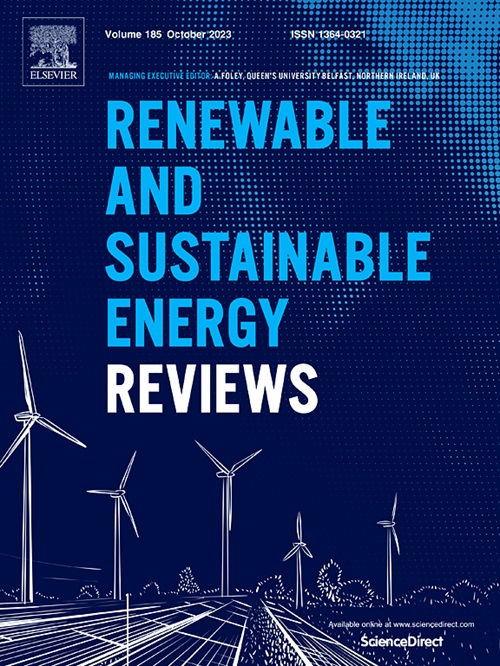Liquid air energy storage – A critical review
IF 16.3
1区 工程技术
Q1 ENERGY & FUELS
引用次数: 0
Abstract
Liquid air energy storage (LAES) can offer a scalable solution for power management, with significant potential for decarbonizing electricity systems through integration with renewables. Its inherent benefits, including no geological constraints, long lifetime, high energy density, environmental friendliness and flexibility, have garnered increasing interest. LAES traces its origins to the first liquid air engine attempt in 1899 and liquid air for peak shaving in 1977. Subsequent advancements in the UK, China, and Japan, signify the progress in the field. However, prior discussions regarding LAES applications have been limited, primarily concentrating on coupled configurations while overlooking decoupled setups. This study provides a comprehensive review of LAES, exploring various dimensions: i) functions beyond load shifting, including frequency regulation, black start, and clean fuel; ii) classification of LAES configurations into coupled systems (standalone & hybrid) and decoupled systems (onshore/offshore energy transmission & liquid air vehicle); iii) challenges facing decoupled LAES, particularly efficiency and hence cost associated with liquid air production (∼0.6–0.75 kWh/kg), as well as low round-trip efficiency (∼20–50 %) related to high-grade cold recovery; iv) highlighting the potential of cold/heat recovery in standalone LAES to enhance thermo-economic performance (round-trip efficiency of ∼50–60 %, payback period of ∼20 years) and the integration of extra cold/heat sources in hybrid LAES for further improvement (round-trip efficiency of ∼50–90 %, payback period of ∼3–10 years). This review aims to provide a comprehensive understanding of LAES, address challenges across configurations, and promote the developments in LAES technology.
液态空气储能--重要评论
液态空气储能(LAES)可为电力管理提供可扩展的解决方案,通过与可再生能源的整合,为电力系统的去碳化带来巨大潜力。其固有的优势,包括不受地质条件限制、使用寿命长、能量密度高、环保和灵活等,引起了越来越多的关注。LAES 的起源可追溯到 1899 年首次尝试使用液态空气发动机,以及 1977 年用于调峰的液态空气。英国、中国和日本随后取得的进展标志着该领域的进步。然而,此前有关液空发动机应用的讨论非常有限,主要集中在耦合配置上,而忽略了解耦设置。本研究对 LAES 进行了全面回顾,从多个方面进行了探讨:i) 负荷转移以外的功能,包括频率调节、黑启动和清洁燃料;ii) LAES 配置分为耦合系统(独立系统和混合系统)和解耦系统(陆上/离岸能源传输系统和液态空气车);iii) 解耦 LAES 面临的挑战,特别是与液态空气生产相关的效率和成本(∼0.6-0.75 kWh/kg),以及与高品位冷回收相关的低往返效率(20%-50%);iv) 强调独立 LAES 中冷/热回收的潜力,以提高热经济性能(往返效率为 50-60%,投资回收期为 20 年),以及在混合 LAES 中整合额外的冷/热源以进一步提高性能(往返效率为 50-90%,投资回收期为 3-10 年)。本综述旨在提供对 LAES 的全面了解,应对各种配置的挑战,并促进 LAES 技术的发展。
本文章由计算机程序翻译,如有差异,请以英文原文为准。
求助全文
约1分钟内获得全文
求助全文
来源期刊

Renewable and Sustainable Energy Reviews
工程技术-能源与燃料
CiteScore
31.20
自引率
5.70%
发文量
1055
审稿时长
62 days
期刊介绍:
The mission of Renewable and Sustainable Energy Reviews is to disseminate the most compelling and pertinent critical insights in renewable and sustainable energy, fostering collaboration among the research community, private sector, and policy and decision makers. The journal aims to exchange challenges, solutions, innovative concepts, and technologies, contributing to sustainable development, the transition to a low-carbon future, and the attainment of emissions targets outlined by the United Nations Framework Convention on Climate Change.
Renewable and Sustainable Energy Reviews publishes a diverse range of content, including review papers, original research, case studies, and analyses of new technologies, all featuring a substantial review component such as critique, comparison, or analysis. Introducing a distinctive paper type, Expert Insights, the journal presents commissioned mini-reviews authored by field leaders, addressing topics of significant interest. Case studies undergo consideration only if they showcase the work's applicability to other regions or contribute valuable insights to the broader field of renewable and sustainable energy. Notably, a bibliographic or literature review lacking critical analysis is deemed unsuitable for publication.
 求助内容:
求助内容: 应助结果提醒方式:
应助结果提醒方式:


